Italian East Africa is the term for the countries around the Horn of Africa under Italian occupation. By 1936, these countries included Italian Somalia, Eritrea, and Abyssinia. Four governates made up Abyssinia (Ethiopia), that include Harar, Galla-Sidamo, Amhara, and Scioa.

Map of Italian East Africa.
During the conflict, Italian soldiers fought against soldiers from the British Empire, Free France, and Belgian Congo, as well as Ethiopian Patriots (freedom fighters).
The Italian East Africa campaign began on 13 June 1940 when Italian forces invaded British Somaliland. However, it ended with an Allied victory on November 27, 1941, following the Battle of Gondar. This war effectively ended the existence of Italian East Africa.
Background
Italy had established the colony of Italian East Africa in 1936. When Italy entered WWII on the Axis side, the neighboring territories of French Somaliland (now Djibouti) and British Somaliland were seen by Mussolini as ripe for annexation to the territory.
The Duke of Aosta, as Viceroy, commanded Italian forces in Italian East Africa and had about 290,476 Italian, colonial and native personnel under his command across the army, naval, and air units at the start of the conflict.
Conflict Begins
Italy looked to consolidate its East African empire and made plans to invade the French and British colonies adjoining the north-eastern parts of Italian East Africa.
Italian forces invaded French Somaliland on 18 June 1940, although hostilities against France officially ended on June 25 by the Armistice of Villa Incisa. This treaty ended the war between Italy and France both in Europe and in Africa.
On 4 July 1940, Italian forces attacked the town of Kassala in Anglo-Egyptian Sudan, capturing and fortifying it. A month later on 3 August 1940, Italian forces invaded British Somaliland.
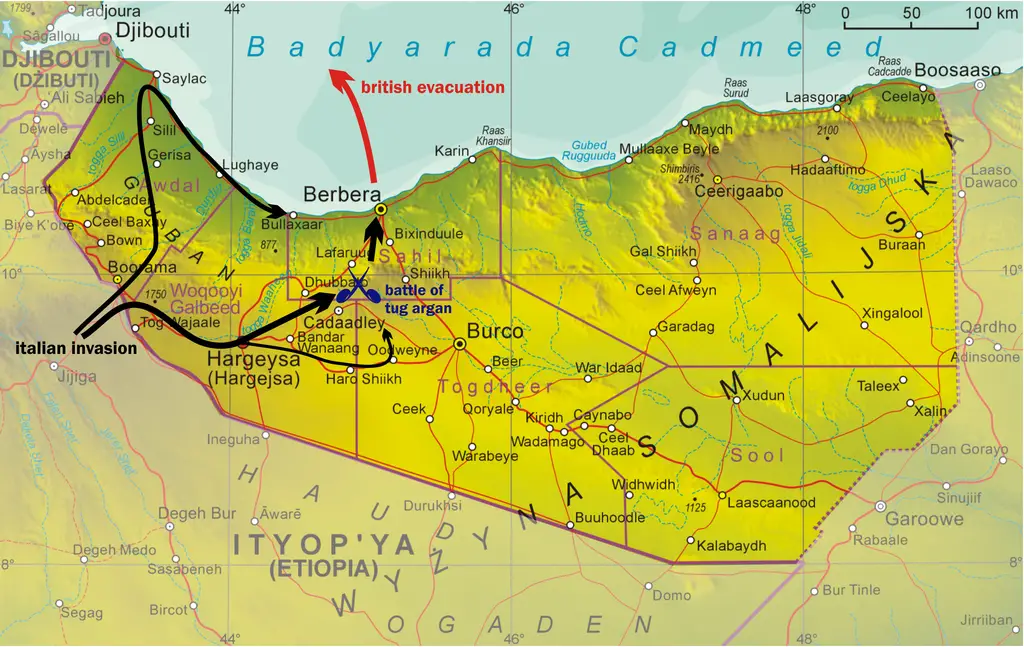
The Italian invasion of British Somaliland.
They won a significant victory against the defending British at the Battle of Tug Argan (August 11-15). This battle caused the British to realize their position was untenable and withdraw to Aden via the port of Berbera, fighting a rearguard action as they did so.

Italian infantry seen here in front of a captured British outpost in British Somaliland.
Italian forces captured the town, and by extension British Somaliland, on August 19. Following the territory’s capture, it was annexed into Italian East Africa.
The conquest of British Somaliland by Italian forces happened fairly quickly. The battle lasted from 3–19 August 1940. Italy won its first victory and added British Somaliland to Italian East Africa. For a detailed report of this battle, see the link below.
Related: Italian Invasion of British Somaliland
Located to the south of Italian-controlled Ethiopia was the British colony of Kenya. As part of the June offensives against the Allies, Italian forces from Ethiopia attacked and captured the border city of Moyale. They pushed about 100km (60 miles) further south before halting their advance at Buna, partly oversupply concerns.
The Tide Turns
Italian control over Somaliland did not last particularly long. From January 1941 Allied forces across the Gulf in Aden were preparing for its recapture, while units in Kenya and Anglo-Egyptian Sudan were also preparing to invade Italian East Africa.
Italy’s forces elsewhere in the Mediterranean had suffered a number of defeats and setbacks. As a result, Italian forces in East Africa took up defensive positions, especially as resupply from Italy was becoming extremely difficult due to the British control of the Suez Canal.
Realizing an invasion was imminent and the territory was of limited strategic importance, as well as the supply situation, the Duke of Aosta ordered an evacuation of occupied British Somaliland. He also ordered Italian East African military units elsewhere to withdraw to more easily defended positions.
On March 16, British forces launched Operation Appearance, landing forces at Berbera. Italian forces offered light resistance before withdrawing inland. The port was soon re-established as a British supply point.
Further West, Allied forces invaded Eritrea from Anglo-Egyptian Sudan. In the south, Italian forces faced attack by advancing British forces, which pushed them back further into Italian East Africa before capturing Mogadishu on 26 February. By 6 April, Allied forces captured Addis Ababa, the capital city in Ethiopia.
The Battle at Sea
Naval battles played an important role in the East African Theater. However, most of the Italian Navy ships in the region did not survive the campaign.
The Regia Marina’s main naval base in Italian East Africa was at Massawa in Eritrea, where much of the Red Sea Flotilla was docked. When the East African campaign began, the Italian Red Sea Flotilla comprised seven destroyers, a colonial ship, some torpedo boats, two gunboats, a minelayer, and eight submarines.
Submarines were the first to enter fighting in the theater. The submarines included the Maccale, Galvani, Galilei, and Ferraris. The Maccale suffered from an air-conditioning unit leaking fluid which gassed the crew. The submarine ran aground on 15 June 1940. Galilei sank the Norwegian tanker James Stove before entering into a gun battle with the Royal Navy. She was ultimately captured and towed to Aden. Ferraris suffered engine problems and ultimately replaced with Torricelli.
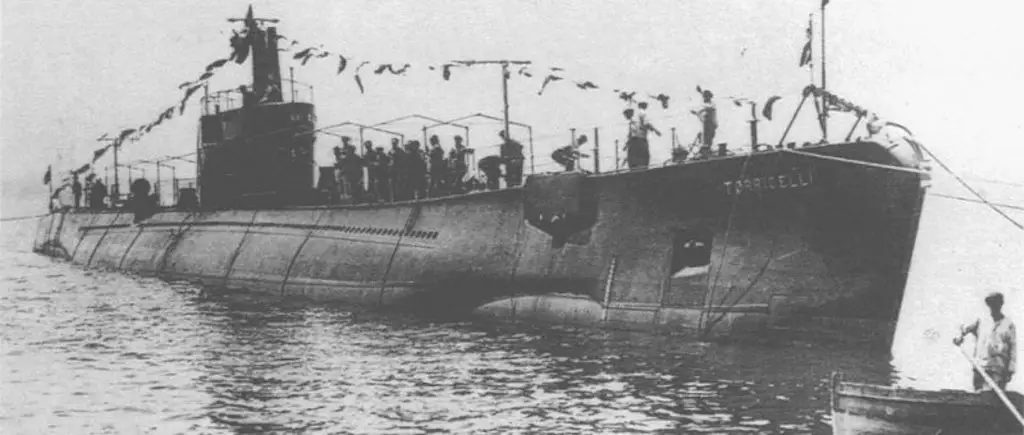
RM Evangelista Torricelli
The Torricelli fought an action against the Royal Navy on 23 June, damaging one British ship and torpedoing another (which later exploded and sank). With no chance of escaping, the Italian submarine commander surrendered after scuttling his boat.
Naval War Ends
Because of the near impossibility of resupply from Italy, fuel and ammunition began to dwindle. The Red Sea Flotilla spent much of the rest of the campaign essentially as a defensive force. Fuel supplies lasted until March 1941, and the Red Sea Flotilla carried out a number of small sorties and actions during this time.
At the end of that month, the Regia Marina command ordered the four remaining submarines back to Europe. They sailed from Massawa and circumnavigated Africa before making it to Bordeaux in occupied France some months later.
On March 31 the remaining combat ships departed from Massawa on a one-way mission to attack Port Sudan. All the ships were sunk by Allied forces or scuttled by their crews.
The Colonial ship Eritrea and the two light cruisers Ramb I and Ramb II received orders to break out and escape to Japan. A New Zealand cruiser intercepted and sank Ramb I on 27 February 1941. The other two ships made it to the port of Kobe.

The Ramb 1 sinks after being hit by HMNZS Leander, on 27 November 1940.
Related: Regia Marina in the Far East: 1940-1945
The few remaining cargo ships received orders to sail for Madagascar (then controlled by neutral Vichy France). Two made it, while another, the Himalaya, sailed across the South Atlantic Ocean to Rio de Janeiro instead.
The one-way missions to Port Sudan and the escape to friendly ports ended the Regia Marina’s presence in the East African Theater. The Red Sea Flotilla ceased to exist after the British captured Massawa on 8 April 1941.
The War in the Air
The Regia Aeronautica (Royal Italian Air Force) in Italian East Africa comprised nine bomber groups plus four independent bomber squadrons, which were operating SM.79, SM.81 and Ca.133 aircraft, and four fighter squadrons equipped with Fiat CR.32 and Fiat CR.42 biplane fighters.
The Savoia-Marchetta SM.82 was the main transport aircraft used in the theater, performing a range of tasks including troop transport, supply missions, and cargo flights.
Some Italian pilots had also fought in the Spanish Civil War, giving them valuable combat experience over the British, South African and Rhodesian pilots they faced.
The Regia Aeronautica began the offensive which opened the southern front of the East African Theater on June 13, 1940, when they bombed the RAF airbase at Wajir in Kenya.
The CR.32 and CR.42 fighters were capable aircraft and piloted by experienced and dedicated airmen. However, they became increasingly outclassed and outnumbered by the RAF aircraft they faced.
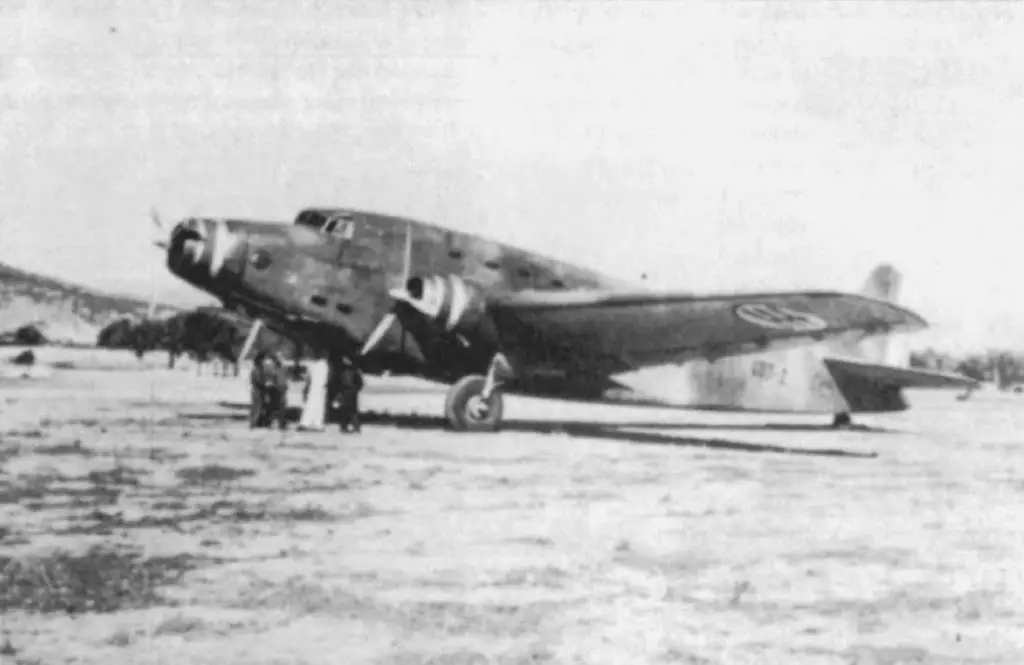
An SM.82 in Addis Ababa, Ethiopia.
Over the course of the conflict in Italian East Africa, most, but not quite all, the locally-based Italian planes were eventually shot down or destroyed in Allied bombing raids or destroyed to prevent the Allies capturing them.
Following the Italian East African forces surrender in November 1941, Regia Aeronautica transport planes supplied Italian guerrilla groups operating in Italian East Africa. On 9 May 1942, an SM.75 flew a 28-hour return flight from Italy to Asmara in now-British-occupied Eritrea. It dropped leaflets to the population below assuring them “Rome is not forgetting you. We shall come back!”
Battle of Keren
Italian forces and their native counterparts were unable or unwilling to mount a strong resistance to the Allied invasions into Italian East Africa. A number of Allied accounts reference Italian forces fleeing, deserting, or surrendering in large numbers as the conflict progressed.
A notable exception to this was at the Battle of Keren (5 February – 1 April 1941) in Eritrea. Determined resistance from about 23,000 Italian and Colonial forces stopped the Allied advance for nearly two months. The fall of Keren opened the way to the port city of Massawa, which surrendered on 8 April 1941.
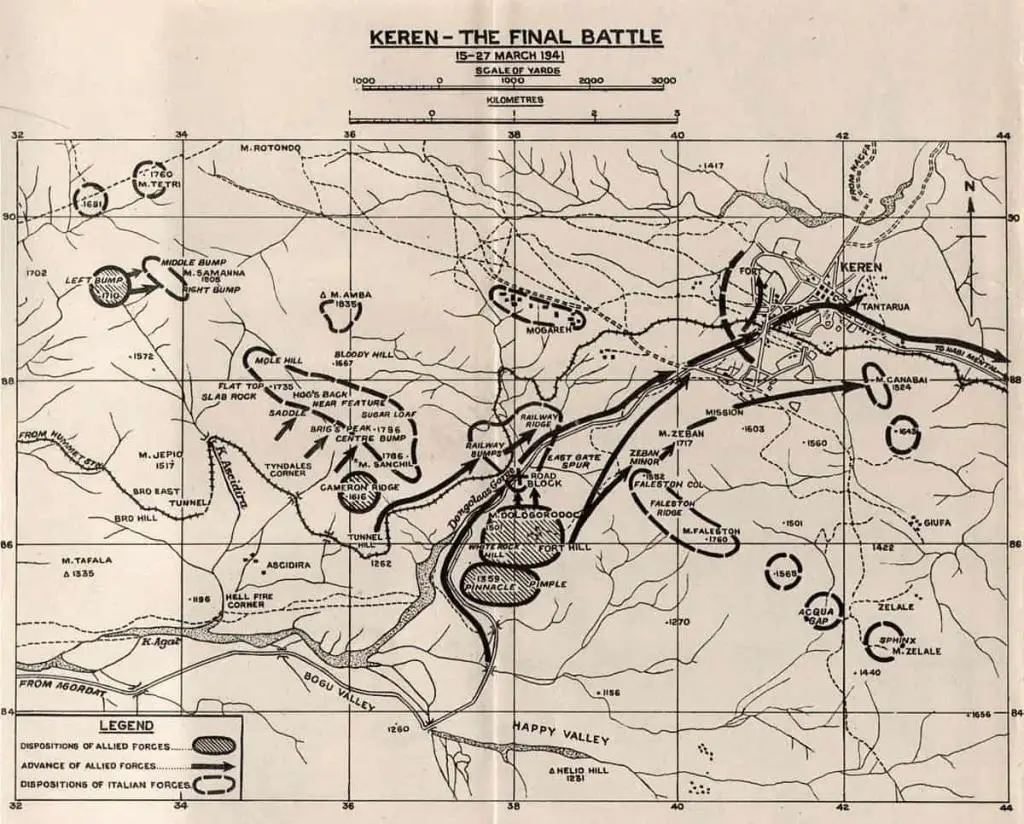
Map of battle of Keren
Related: Italian Resistance at the Battle of Keren
In Eastern Epic, an official Military History of the British & Indian Army in WW2, author Compton Mackenzie penned the following:
Keren was as hard a soldiers’ battle as was ever fought, and let it be said that nowhere in the war did the Germans fight more stubbornly than those [Italian] Savoia battalions, Alpini, Bersaglieri, and Grenadiers… The unfortunate license of wartime propaganda allowed the British Press to represent the Italians almost as comic warriors, but except for the German parachute division in Italy and the Japanese in Burma no enemy with whom the British and Indian troops were matched put up a finer fight than those Savoia battalions at Keren.

Indian soldiers firing British 18 pounders at Italian forces during the Battle of Keren.
End of Conflict in Italian East Africa
Italian forces had fortified positions at Amba Alagi in northern Ethiopia, where the Duke of Aosta and his men fought valiantly until May 19. They surrendered after running out of water, supplies, and becoming overwhelmed by enemy numbers. The defense became later romanticized in the 1953 film La pattuglia dell’Amba Alagi.
Italian forces in East Africa made their last stand at Gondar between November 13-27. The 40,000 soldiers fought the combined British and Ethiopian Patriot forces until supplies ran out, forcing the Italian surrender.
The fall of Gondar was not the end of fighting in the region, however. Several thousand Italian soldiers escaped into the countryside and continued to wage a guerrilla war against the British. The area became tranquil only after the Italian Armistice on 8 September 1943.
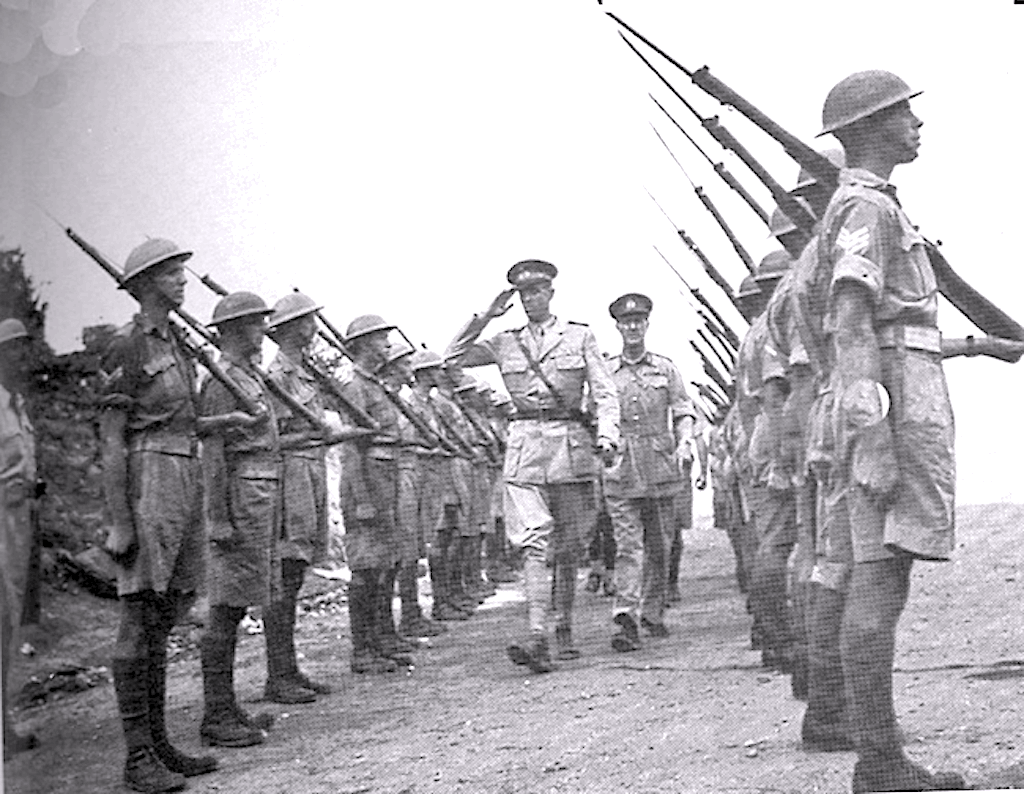
The Duke of Aosta during the surrender to the British.
The Armistice not only ended Italy’s conflict with the Allies, it effectively ended the existence of Italian East Africa, and the territory came under British administration.
References:
The Mediterranean and Middle East Volume I The Early Successes Against Italy (to May 1941)
The Final Campaign in East Africa
How Italy was Defeated in East Africa in 1941
London Gazette
Researchomnia
La Regia Marina
Warfare History Network
Storia Verita